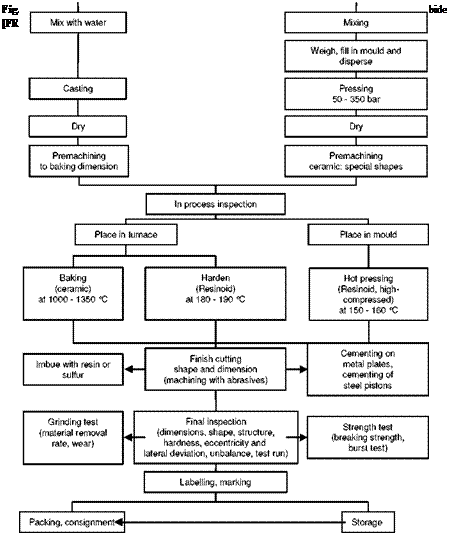3.4.1 The Manufacture of Tools with Conventional Abrasives
The production of abrasive tools bonded with vitrified and synthetic resins is the same from the standpoint of the manufacturing sequence. Yet manufacturing processes do differ because bond properties vary in some points. Fig. 3-18 provides an overview of the particular production steps.
3.4.1.1 The Manufacture of Resin Bonded Grinding Wheels
The production of a grinding component with a synthetic resin bond is divided essentially into three operations:
• production of the grinding wheel mixture,
• pressing the mixture to blanks,
• hardening of the blanks in the hardening furnace.
In the mixing process, the grits wetted with liquefied phenol resin are mixed in with the resin powder as well as fillings and auxiliaries, such as furfurol and cre — sol, in accordance with the given quantitative ratio. The mixing process is continued until a homogeneous, pourable mass is formed, which should not be too moist or lumpy, yet should also contain no noticeably dusting parts. Due to the reaction of both resins already initiating directly after mixing, the grinding wheel mixture is not a stable system, by means of which clumping of the mixture can occur under natural pressure. In order to produce unvarying grinding wheel qualities, besides keeping mixing times constant, the mixture is made in air-conditioned spaces, so that the influences of temperature and humidity can be better controlled.
For shaping, the press mixture, which has been sifted once again, is weighed precisely and poured into the mould. In order to avoid inhomogeneities that could later effect operation, e. g. in the form of imbalance or structural or hardness disparities, the mixture is spread evenly in the mould. Compression occurs by means of hydraulic presses at pressures in the area of 15 to 30 N/mm2.
|
Abrasive corundum silicon carbide |
Bond vitrified resin |
Additive glue, pore additive, etc. |
||
|
і _______________ |
____ |
Weigh out
like composition
 |
і——————- 1 ———————————————- 1
With the exception of hot-pressed grinding wheels, pressing takes place at room temperature. In the process, two different pressing variations are distinguished. In the case of volume pressing, there is a compression to a given final volume corresponding to shape and weigh-in quantity. In pressure dependent pressing, the grinding wheel mixture is supplied with an empirically determined pressure. The pressing time usually amounts to 5 to 30 seconds. After removing the blanks or “green discs” from the mould and a temporary storage the hardening process follows.
Resin bonded grinding wheels harden predominately in periodic chamber furnaces. For consistent air circulation, the blanks are placed in large numbers on porous ceramic plates. During hardening, the following processes take place according to the actual temperature:
• conversion of the resin bond to a molten state (70 to 80 °C),
• initiation of the hardening of the molten resin powder by the decomposition of hexamethylentetramine (110 to 120 °C),
• maximal cross-linking of the phenol resin (170 to 180 °C) and
• improvement in the thermal stability of the resin bond with a simultaneous embrittlement by means of an separation of benzylamin structures with ammonia development (180 to 200 °C).
It is common to all temperature regulations in chamber furnaces, which are adjusted in accordance with the respective grinding wheel dimensions and the desired final strength, that a hold time is inserted in the phases with a precipitation of the volatile components water, phenol and also ammonia. The total duration of the hardening process can take up to 60 hours for large-volume grinding components.
For the hot pressing of grinding wheels bonded with synthetic resin, nearly water-free wetting agents are used as a rule. Compression takes place in multi-plate presses in temperatures of 150 to 170 °C. Pressing times average between 20 and 60 minutes, depending on the geometry. Subsequently, a final wetting takes place in a furnace heated at 180 to 190 °C temperatures.
Epoxy, polyester or polyurethane bonds are processed with curing agents as dual component systems from the liquid phase to casting or shaking materials, which are poured into moulds for hardening. Hardening occurs in the mould at temperatures ranging from 20 to 80 °C [COLL88].
